On a company-sponsored cruise, 2/3 of the passengers were company employees and the remaining passengers were their guests. If 3/4 of the company-employee passengers were managers, what was the number of company-employee passengers who were NOT managers?
1) There were 690 passengers on the cruise
2) There were 230 passengers who were guests of the company employees.
Company cruise
This topic has expert replies
- Patrick_GMATFix
- GMAT Instructor
- Posts: 1052
- Joined: Fri May 21, 2010 1:30 am
- Thanked: 335 times
- Followed by:98 members
- Check out my site: GMATFix.com
- To prep my students I use this tool >> (screenshots, video)
- Ask me about tutoring.
GMAT/MBA Expert
- Brent@GMATPrepNow
- GMAT Instructor
- Posts: 16207
- Joined: Mon Dec 08, 2008 6:26 pm
- Location: Vancouver, BC
- Thanked: 5254 times
- Followed by:1268 members
- GMAT Score:770
One approach is to use the Double Matrix Method. This technique can be used for most questions featuring a population in which each member has two characteristics associated with it.kobel51 wrote:On a company-sponsored cruise, 2/3 of the passengers were company employees and the remaining passengers were their guests. If 3/4 of the company-employee passengers were managers, what was the number of company-employee passengers who were NOT managers?
1) There were 690 passengers on the cruise
2) There were 230 passengers who were guests of the company employees.
Here, we have a population of passengers, and the two characteristics are:
- company employee or not company employee
- a manager or not a manager
Aside: To learn more about this technique, watch our free video: https://www.gmatprepnow.com/module/gmat- ... ems?id=919
Okay, onto the question...
Target question: What was the number of company-employee passengers who were NOT managers?
Given: 2/3 of the passengers were company employees and the remaining passengers were guests. 3/4 of the company-employee passengers were managers.
Let's begin by setting up our diagram to show the two sets of characteristics:

Since we don't know the total number of passengers, let's let x = total number of passengers:

If "2/3 of the passengers were company employees and the remaining passengers were guests," then 1/3 are guests. This means the sum of the boxes in the left-hand column is (2/3)x and the sum of the boxes in the right-hand column is (1/3)x:
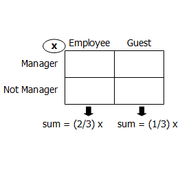
Then we're told that "3/4 of the company-employee passengers were managers"
So 3/4 of the (2/3)x passenger were managers.
3/4 of (2/3)x = (1/2)x, so (1/2)x passengers were managers:
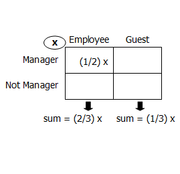
Since the sum of the two boxes in the left-column must add to (2/3)x, we can conclude that the other box must be (1/6)x, so we can add that here.
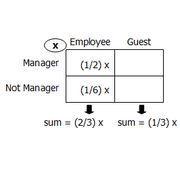
IMPORTANT: Since none of the guests were managers, we know that the top-right box contains zero passengers as follows:
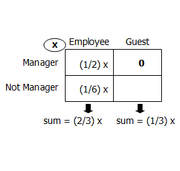
Finally, the sum of the two boxes in the right-column must add to (1/3)x, we can conclude that the other box must be (1/3)x, so we can add that here.
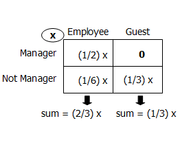
Okay, our goal is to determine the number of company-employee passengers who were NOT managers. In other words, we want to know the number of passengers in the bottom-left box. So, let's place a STAR in this box to remind us of this:
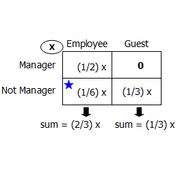
We're now ready to check the statements...
Statement 1: There were 690 passengers on the cruise
In other words, x = 690
From this, we can take our diagram and plug in 690 for x:
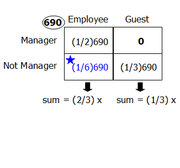
As we can see, we can determine the number of passengers in every box, which means we can definitely determine the number of company-employee passengers who were NOT managers
Since we can answer the target question with certainty, statement 1 is SUFFICIENT
Statement 2: There were 230 passengers who were guests of the company employees.
In other words, the boxes in the left-hand column have a sum of 230
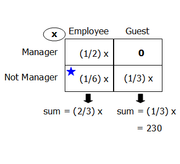
If (1/3)x = 230, we can determine the value of x.
Once we know the value of x, we can we can definitely determine the number of company-employee passengers who were NOT managers
Since we can answer the target question with certainty, statement 2 is SUFFICIENT
Answer = D
-----------------------------
Once you are familiar with the Double Matrix Method, you can attempt these additional practice questions:
Easy Problem Solving questions
- https://www.beatthegmat.com/the-aam-aadm ... 72242.html
- https://www.beatthegmat.com/finance-majo ... 67425.html
Medium Problem Solving questions
- https://www.beatthegmat.com/probability- ... 73360.html
- https://www.beatthegmat.com/posted-speed ... 72374.html
- https://www.beatthegmat.com/motel-t271938.html
- https://www.beatthegmat.com/of-the-appli ... 70255.html
- https://www.beatthegmat.com/opening-nigh ... 64869.html
- https://www.beatthegmat.com/ds-french-ja ... 22297.html
Difficult Problem Solving questions
- https://www.beatthegmat.com/ratio-problem-t268339.html
- https://www.beatthegmat.com/overlapping- ... 65223.html
- https://www.beatthegmat.com/fractions-t264254.html
- https://www.beatthegmat.com/overlapping- ... 64092.html
- https://www.beatthegmat.com/mba/2011/05/ ... question-2
Easy Data Sufficiency questions
- https://www.beatthegmat.com/for-what-per ... 70596.html
- https://www.beatthegmat.com/ds-quest-t187706.html
Medium Data Sufficiency questions
- https://www.beatthegmat.com/sets-matrix-ds-t271914.html
- https://www.beatthegmat.com/each-of-peop ... 71375.html
- https://www.beatthegmat.com/a-manufacturer-t270331.html
- https://www.beatthegmat.com/in-costume-f ... 69355.html
- https://www.beatthegmat.com/mba/2011/05/ ... question-1
Difficult Data Sufficiency questions
- https://www.beatthegmat.com/double-set-m ... 71423.html
- https://www.beatthegmat.com/sets-t269449.html
- https://www.beatthegmat.com/mba/2011/05/ ... question-3
Cheers,
Brent





















